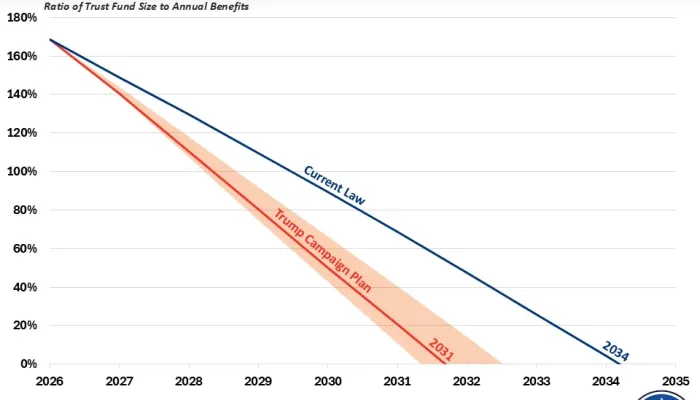Donald Trump’s Proposal to Lower the Corporate Tax Rate to 15%
President Trump recently proposed lowering the corporate tax rate from 21 to 15 percent for corporations that make their products in America. Under one possible structure, we estimate this could reduce revenue by about $200 billion through Fiscal Year (FY) 2035.
Lowering the corporate tax rate to 15 percent for all corporations would reduce revenue by about $460 billion to $675 billion through FY 2034. While President Trump’s proposal to apply this cut more narrowly lacks important details, one option would be to structure it like the Section 199 domestic production activity deduction that was in place from 2004 to 2017. We estimate that applying this change instead of lowering the rate for all corporations would reduce revenue by about one-third as much.
US Budget Watch 2024 is a project of the nonpartisan Committee for a Responsible Federal Budget designed to educate the public on the fiscal impact of presidential candidates’ proposals and platforms. Throughout the election, we will issue policy explainers, fact checks, budget scores, and other analyses. We do not support or oppose any candidate for public office.
During his remarks at the Economic Club of New York, President Trump stated that his plan calls for (among other items) “a reduction in the corporate tax rate from 21 percent to 15 percent solely for companies that make their product in America,” in an effort to “further support the revival of American manufacturing.” He further said companies that “outsource, offshore, or replace American workers” would not be eligible for the benefit.
While it is unclear how this proposal would be structured, cutting the corporate tax rate to 15 percent for all corporations would reduce revenue by $595 billion to $673 billion, based on conventional estimates from the Penn Wharton Budget Model and Tax Foundation, or as low as $460 billion under Tax Foundation’s dynamic estimate. This proposal would likely have a much smaller fiscal impact.
One way this could be implemented would be to revive a modified form of a previous tax deduction, the domestic production activity deduction – also known as the “manufacturers’ deduction” or “199” – which was established in 2004 and repealed by the Tax Cuts and Jobs Act (TCJA) in 2017.
The domestic production activity deduction offered businesses a 9 percent deduction for income generated from goods that were manufactured, produced, grown, or extracted domestically. This effectively reduced the 35 percent corporate income tax rate at the time to 31.85 percent on most domestic manufacturing as well as construction, energy production, agriculture, and other sectors.
The deduction was repealed in the TCJA to help offset the revenue loss from lowering the corporate rate from 35 to 21 percent.
To further reduce the effective corporate tax rate to 15 percent for domestic manufacturers, one option would be to revive this deduction for corporations and set it to 28.6 percent.
Since about one-third of corporate taxable income qualified for the deduction and the pre-TCJA cost of the corporate tax expenditure was about one-third as large as an equivalent rate cut, it is likely that adopting this approach for a 15 percent effective rate today would cost about one-third as much as lowering the full corporate rate to 15 percent.
Under this scenario, President Trump’s proposal would reduce revenue by approximately $200 billion from FY 2026 through 2035.
Revenue Loss From a 15% Corporate Tax Rate
| Ten-Year Revenue Loss | |
|---|---|
| Reduce corporate rate to 15% (PWBM) | $595 billion |
| Reduce corporate rate to 15% (Tax Foundation) | $673 billion |
| Reduce corporate rate to 15% (Tax Foundation, dynamic) | $460 billion |
| Re-establish domestic production activity deduction (199) for corporations with a 15% effective rate | ~$200 billion |
Source: Penn Wharton Budget Model (PWBM), Tax Foundation, Joint Committee on Taxation, Committee for a Responsible Federal Budget.
Note: PWBM and Tax Foundation estimates are over the ten-year period from FY 2025 through 2034.
The actual revenue loss could be much higher or much lower depending on how the rate reduction is ultimately achieved.
This estimate does not incorporate President Trump’s additional proposals to extend expanded R&D tax credits, 100 percent bonus depreciation, and expensing for new manufacturing investments, which he also stated would only be available to domestic producers.
*****
Throughout the 2024 presidential election cycle, US Budget Watch 2024 will bring information and accountability to the campaign by analyzing candidates’ proposals, fact-checking their claims, and scoring the fiscal cost of their agendas.
By injecting an impartial, fact-based approach into the national conversation, US Budget Watch 2024 will help voters better understand the nuances of the candidates’ policy proposals and what they would mean for the country’s economic and fiscal future.
You can find more US Budget Watch 2024 content here.


